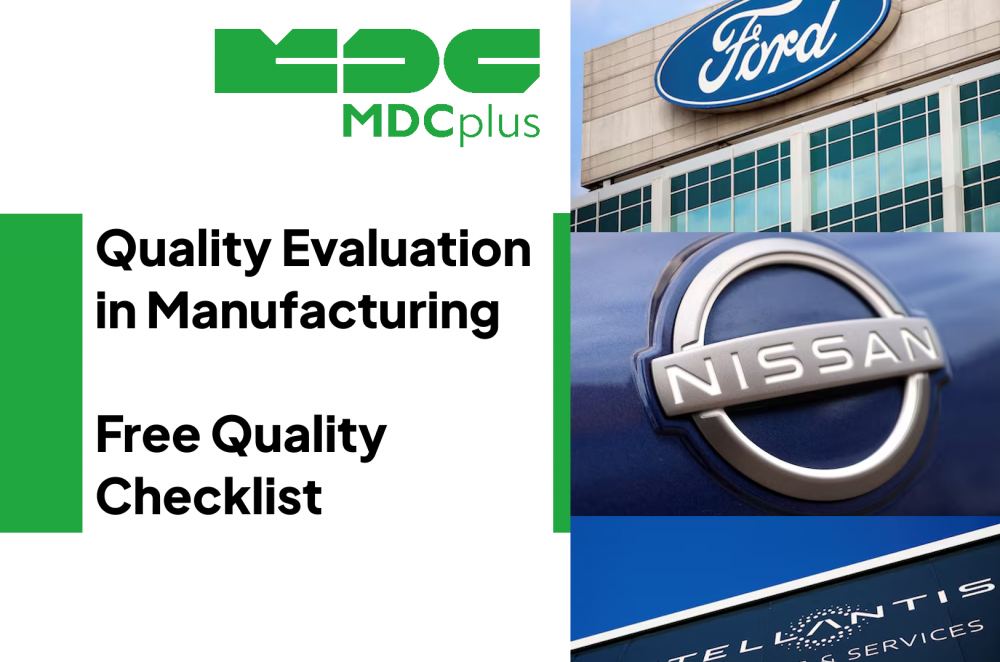Quality Evaluation in Manufacturing + Free Quality Checklist
When manufacturing fails to maintain consistent quality, the impact is immediate: costly recalls, damaged brand trust, and lost customer confidence.
Recent Examples from the Automotive Industry
Stellantis: Nearly 300,000 vehicles were recalled due to a shifter cable issue that could cause rollaway incidents. The root cause points to tolerance variation and assembly consistency — areas that robust in-line inspection could have caught earlier.
Nissan: Over 173,000 vehicles were recalled because of wiring harness routing faults that could stall engines. This indicates gaps in supplier quality assurance and incoming inspection protocols.
Ford: Almost 60,000 vehicles were recalled due to cracks in engine block heaters, creating a fire risk. This shows weaknesses in component testing and process validation, especially under stress and temperature cycles.
Each case represents a different breakdown — mechanical, electrical, or materials-related — yet all share the same underlying problem: a quality control process that detected issues too late.
Understanding Quality Evaluation
Quality evaluation in manufacturing is the continuous assessment of processes, materials, and outputs to ensure every part meets specification before reaching the customer. It’s not limited to inspection at the end — it’s about embedding quality into every stage.
Key objectives of quality evaluation:
- Detect defects as early as possible
- Reduce process variation and uncertainty
- Improve reliability and performance consistency
- Create traceability from raw material to final product
- Build customer trust through predictable quality
Building Blocks of a Strong Quality Evaluation System
1. Design for Quality (DfQ)
Quality begins at the design phase. Engineering teams should use failure mode and effects analysis (FMEA) and tolerance stack-ups to predict potential weaknesses before production starts.
2. Supplier Quality Management
Incoming materials determine product quality. Strong supplier audits, certificates of conformity, and random sampling tests are mandatory. A weak supplier quality program is often where large recalls start.
3. Process Control and Monitoring
Statistical Process Control (SPC), automated data collection, and clear deviation thresholds allow real-time monitoring of production stability. Machines and operators should detect variations before they become defects.
4. In-Process Inspections and Quality Gates
Rather than waiting for final inspection, introduce quality gates at each critical stage — setup, machining, assembly, and finishing. Every gate acts as a filter to prevent defective material from moving forward.
5. Traceability and Data Integrity
Digital traceability (batch IDs, serial numbers, timestamped results) is crucial for root cause analysis. Without traceable data, defect investigations rely on guesswork.
6. Root Cause and Corrective Action (RCCA)
When an issue occurs, the process must trigger a structured analysis (5-Why, Fishbone). The goal isn’t to fix the symptom, but to eliminate the underlying cause permanently.
7. Continuous Improvement
Quality systems must evolve with production. Regular audits, KPI reviews, and training ensure that standards don’t decay over time.
Common Pitfalls and How to Avoid Them
- Late detection: relying on final inspection rather than prevention.
- Data overload: collecting data without analysis or action.
- Supplier blind spots: assuming parts from vendors meet spec.
- Cultural resistance: operators seeing quality checks as bureaucracy.
- Metric distortion: when teams chase KPI numbers instead of real improvements.
Each of these pitfalls can cascade into warranty claims or recalls if not addressed systematically.
Integrating Digital Quality Systems
Modern manufacturing requires real-time visibility. A connected quality evaluation system integrates with MES or QMS platforms to collect inspection data automatically. AI-driven analytics can detect subtle deviations, predict equipment issues, and trigger alerts before non-conformances reach the customer.
Digitalization turns quality from a reactive department into a proactive capability. Predictive models, automated SPC dashboards, and digital twins can simulate how small process drifts may lead to failures — providing time to act before defects appear.
Next Steps
Consistent quality is not an outcome of good luck; it’s engineered through structure, discipline, and data. The automotive recalls of 2025 demonstrate what happens when evaluation lapses — even briefly.
To strengthen your own operations:
- Map where and how quality is checked today.
- Identify points of failure or delays in detection.
- Implement structured quality gates and traceability.
- Automate data collection and integrate with MES/QMS.
- Train teams to act on deviations, not just record them.
A well‑structured quality evaluation process transforms customer trust from a hope into a measurable result.
Download MDCplus Quality Checklist - a practical tool for auditing and improving your factory’s quality control system.
About MDCplus
Our key features are real-time machine monitoring for swift issue resolution, power consumption tracking to promote sustainability, computerized maintenance management to reduce downtime, and vibration diagnostics for predictive maintenance. MDCplus's solutions are tailored for diverse industries, including aerospace, automotive, precision machining, and heavy industry. By delivering actionable insights and fostering seamless integration, we empower manufacturers to boost Overall Equipment Effectiveness (OEE), reduce operational costs, and achieve sustainable growth along with future planning.
Ready to increase your OEE, get clearer vision of your shop floor, and predict sustainably?
